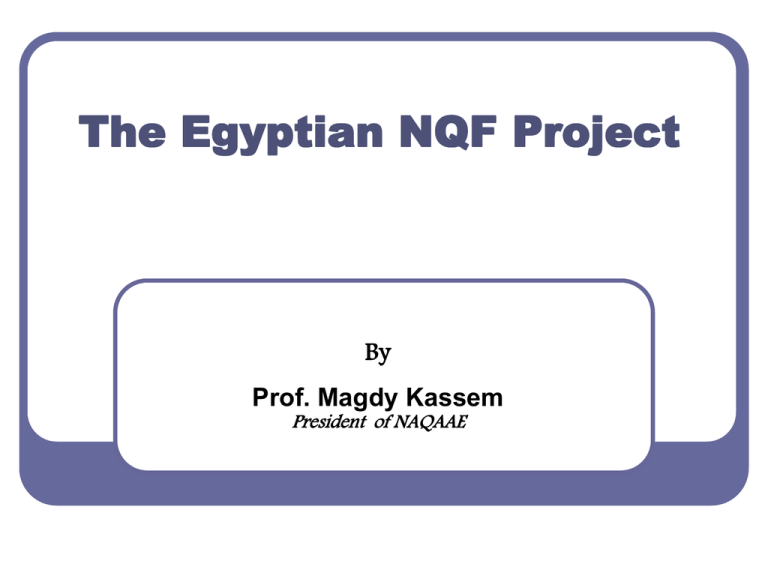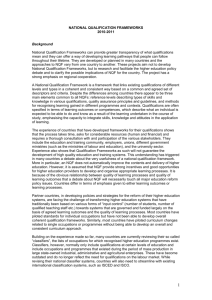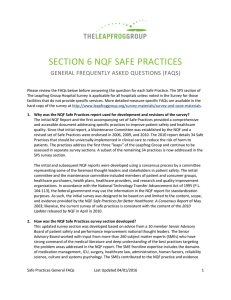naqaae
advertisement

The Egyptian NQF Project By Prof. Magdy Kassem President of NAQAAE Scope History Objectives of the Eg- NQF Outline of the Eg-NQF General applications of the NQF Sectorial applications of the NQF) TVET included) Supporting policies & Tools What’s next NAQAAE NQF - Egypt a NAQAAE Responsibility History Education reform in Egypt >>>>>Driving forces Mismatch between education system output and labor market demand Decreasing competitive edge of Egyptian graduates in the regional labor market Social factors (need to increase access, address illiteracy &leakage from education, … Current education system defects ( bottle necks & dead ends, overlap of qualifications , no recognition of learning outside the formal context…… NAQAAE In 2006, As a capstone to the education reform strategy, NAQAAE was established as the sole accrediting body of Egyptian education. NAQAAE EG NQF >>>>Why NAQAAE By law mandate: NAQAAE is an overarching all levels & types of education. NAQAAE is responsible for QA of education as well as for ensuring recognition of and confidence in the output of the Egyptian education system. The law granted NAQAAE the authority to set standards & policies and to develop the tools needed to fulfill its responsibilities. NAQAAE authority To carry its responsibilities NAQAAE had to Set quality assurance & accreditation standards Set ARS for different specialties and levels of qualifications The ARS had to be benchmarked against qualification level descriptors (Hence the need to set a NQF emerged) Establish means for comparability of Egyptian qualifications in quest of their recognition (a NQF needed) . NAQAAE NAQAAE gathered a task force and worked on a project for an Egyptian NQF development. The NQF project was submitted to the prime minister and ...... NQF – Egypt was officially assigned to NAQAAE NAQAAE Purposes of the Eg-NQF Purposes of the Eg-NQF 1. Setting reference standards for qualification levels based on learning outcomes 2. Acting as a reference to build qualification frameworks for different sectors /sub sectors 3. Serving as a comparability tool for recognition of Egyptian qualifications. NAQAAE Purposes of the Eg-NQF 4. Linking qualification levels allowing progression from one level to another 5. Linking TVET & the general education systems, promoting level progression and horizontal mobility 6. Guiding QA standards (and ARS) setting both by providers of education and EQA bodies. NAQAAE Purposes of the Eg-NQF 7. Permitting inter sectorial mobility (with appropriate tools) 8. Providing reference standards to review and enhance standing Eg qualifications, and acting as a benchmark when introducing new qualifications. 9. Assuring public confidence in the outcomes of the EG Q system by meeting societal and employers’ expectations for different Q levels. 10. Fostering LLL and RPL NAQAAE Outline of the proposed Eg-NQF Outline of the proposed Eg-NQF 8 levels described in terms of LO. Qualifications are measured against these outcomes in order to be placed at a given level. Levels are ascending, starting at L1 (equivalent to the general primary certificate) up to L8 (equivalent to a doctoral degree) NAQAAE Outline of the proposed Eg-NQF One or more NQ may fit into a level . Level descriptors include: • knowledge (extent and type) • skills (cognitive & professional) • competencies ( autonomy, responsibility & interaction) NAQAAE level 8 7 6 5 4 3 2 1 Knowledge type skills exten cogn Prof competencies Auto. Resp Inter Qual G TV Other Min of education HE 8 Doct. 7 masters 6 Grad. diploma 5 Bachelor CQF LLL & professional development Certificates levels 1-8 Vocational & professional Q NSS 5 NSS 4 4 3 5 yr General sec certificate Tech sec. Cert 3yr 2 1 Tech diplom. NSS 3 NSS 2 NSS 1 Compulsory education











